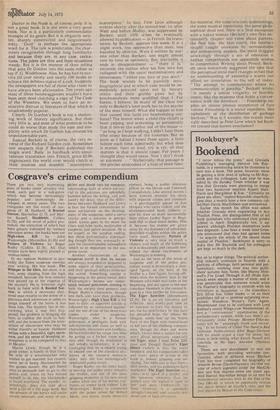Cosgrave's crime compendium
There are two very interesting pairs of books under scrutiny this week, each pair in a sub-genre which has become increasingly Popular, and increasingly developed, in recent years. The two categories are the novel of suspense (P, M, Hubbard, A Rooted Sorrow, Macmillan £1,75, and Martin Russell, Do ublehi t, Collins £1.70); and the novel of police procedure, the attraction of which has been greatly enhanced by various television series: the books here are Kill by John Wainwright (Macmillan E1.95) and Pattern of Violence by Roger Busby (Collins £1.70). All four writers have been highly praised at various times.
In my opinion Hubbard is pro bably the finest suspense novelist now writing. His last book, The Whisper in the Glen, did show, it is true, some slipping from his high standard, because the love interest Was played up at the expense of the mystery. He is, however, right back to form with A Rooted Sorrow, in which a nervously shattered man returns to the scene of a previous dark adventure in order to purge himself of the harm it has done him. The mystery lies in discovering what it was that happened; the problem in bringing the hero to confess the truth to himself; and the tension from the interaction of characters who may be either friendly or hostile. Hubbard writes with a beautiful, tight spareness, and his sense of brooding atmosphere is to be compared to that in Ma uriac.
Martin Lewis, though he is a good writer, is hardly in that class. He tells of a. schoolteacher who wishes to get married, but cannot, since he is being blackmailed by the games master. His girl friend tries to persuade him to go to the police and, when he has nerved himself to do this, the blackmaikr iS found murdered. The murder. interestingly, does not take place until p. 124 of a 192 page book. But the erosion of the hero's will under steady pressure, and entry of sus picion and doubt into his romantic relationship. both of which are crucial to the solution, are splendidly handled before the killing, and well justify the delay. One of the differences between Hubbard and Lewis is that the former concentrates almost exclusively on the development of the suspense, until a nerve cracks and a solution is precipitated. Lewis goes in far more for clues and false trails, multitudes of suspects, a,nd police intuition. He is an expert at the surprise ending: but these pyrotechnics, entertaining though they are, eventually injure the claustrophobic atmosphere which is so important to the suspense novel,
Another characteristic of the 'suspense novel is that its heroes are always wounded or impaired in some aspect of their personalities; and their spiritual defects influence the action. Something similar is happening in the police novel. John Wainwright's heroes are embittered, bruised policemen, coming to hate the society they protect; and Roger Busby's characters, though less dark, also have their problems. Wainwright's High Class Kill is his best to date: an apparent suicide is followed by an undoubted murder, and the son of one of the detectives
comes under suspicion. Wainwright, who is a former policeman, is profligate, both with sub-mysteries and clues, as well as characters, sit nations and conflicts. He has extended his range this time by giving us a locked room mystery and, though its resolution is not wholly satisfactory, it is encouraging that he is clearly trying to absorb one of the classical situations of the classical detective story into the too sociologically orientated police novel.
Roger Busby, on the other hand, is moving the police story • towards the thriller; and one of the most gripping moments in his new novel comes when one of his heroes confronts an armed bank robber. Like Wainwright, Busby is connected with the police (even Sir Robert Mark. you know, reads detective stories), being a public relations officer to the Devon and Cornwall Constabulary. Like several novels I have noticed recently his deals with separate crimes and criminals — a psychopathic passer of dud cheques who turns violent, and the aforementioned bank robbers — and he does so more successfully than either Lesley Egan or Reginald Hill in their latest books. This is because his stories are given unity by the dynamics of admirably described rivalries within the police force itself, However, Pattern of Violence is very slow to reach a climax, and much of the bobbying in it is desultorily and casually described: the dense excitement of Wainwright is missing.
Just as the hero of the novel of suspense and of the police procedure novel is increasingly a damaged figure, so the hero ()I. the thriller is a lone figure, having a ffini ties with the mystery man in the Western who rides into town at the beginning and out again at the end. Jonathan Hemlock is the central figure in a first thriller by Trevaniarf, The Eiger Sanction (Heinemann £2.10). He is an art historian and collector, who works part time as an assassin to earn the money to pay for his proclivities. In this yarn his dreadful boss, the albino Mr Dragon, sends him up the North Face of the Eiger with instructions to kill one of 'his climbing companions, though he does not know which. I have been a sucker for any story about mountains. especially the Eiger, since I read Peter Gillman and DOugai Hast011'S Eiger Direct (which. is also the route Hemlock and his companions take) and e%,ery piece of action in the
book is, indeed, gripping and terrifying. The difficulty is that TrevaMan wrote, and his publishers have marketed, The Eiger Sanction jokey. sexy spoof of a thriller, and the nonsense elements thus im ported into the narrative spoil its line and pace. Underneath the II oss , however, is a :;plendilly straight-forward titul iciltelv rendered tale of high ;idventore.'






























 Previous page
Previous page